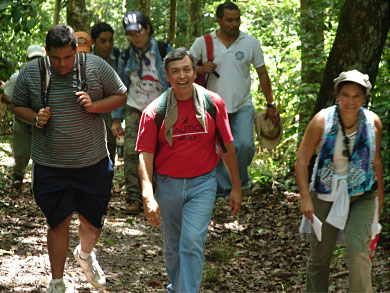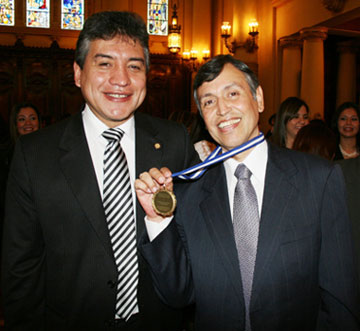

![]()
![]()
![]()
![]()
| [This appreciation was presented at the symposium "Sociétés mayas millénaires: Crises du passé et résilience," Musée du Quai Branly, Paris, 2 July 2011.] |
|
It is difficult to speak about Dr. Juan Antonio Valdés so shortly after his untimely death on July 21, and even more so to attempt to encapsulate the entirety of a lifetime dedicated to archaeology, education, and the improvement of the cultural politics of our country. Such achievements cannot be summarized in a few moments, but I will try to highlight the ones that seem to me most significant.
Juan Antonio was born on March 15, 1954, in San Cristóbal, Alta Verapaz, to a loving and traditional family. The son of Don Luis Valdés and Doña Julia Gómez de Valdés, he was the second youngest of eight children, and is survived by his mother and five siblings. In one of the last interviews he gave to a newspaper, the reporter described him as "a sensitive, positive and sincere person, passionate about the history of his country, who since his childhood has enjoyed reading about the legends and traditions of Guatemala." These early and abiding interests eventually led him to study at the School of History of the Universidad de San Carlos de Guatemala. When he began his studies in San Carlos in 1973 an archaeological specialization still did not exist as such, but this track soon appeared and Juan Antonio was the second person in Guatemala to obtain his licenciado (bachelor's) degree in archaeology, graduating as a professional in 1979. Despite it being an unconventional career with seemingly "little future" in our country, Juan Antonio ventured into what would become his passion for the rest of his life: archaeology. In 1980 he came to Paris to continue his studies, taking courses in prehistoric and protohistoric ethnology at the Sorbonne, and earning his doctorate in archaeology in 1982. In the process, he became the first Guatemalan to obtain this degree in such a prestigious university. Now back in Guatemala, Juan Antonio participated in many archaeological projects, directed excavations and research projects, and served as a professor at both the Universidad de San Carlos and the Universidad del Valle de Guatemala. Additionally, he was frequently invited to Mexico to give lectures and refresher courses at the Universidad Nacional Autónoma de México. He directed and advised several theses and provided numerous opportunities for students to work on his projects, frequently assisting them in obtaining scholarships for study abroad. As a teacher he was strict, but he enjoyed a job well done and could become annoyed on those occasions when his students' work did not live up to their promise. Yet his teaching was not limited to transmitting his vast knowledge; he also passed along his values, and motivated his students to perform work of quality, to conduct themselves ethically, and to have respect for others. His attitude as a teacher can be tidily summed up with the well known saying that "we must lead by example." Without doubt, Juan Antonio's example left an indelible mark on his students, and on the practice of archaeology in Guatemala. He took an active role in shaping all the generations of archaeologists who will follow him.
Juan Antonio was always smiling, always generous and friendly, and always willing to help and to lend a hand to anyone who asked him. This is how I will always remember him: as a good man, always looking on the bright side of things. If he made criticisms, he did so always with the desire to improve things, since he held that all things could be improved. He was an expert at finding solutions to problems, and to hear him speak nothing seemed impossible. He never lost his objectivity, and was always open to new ideas and possibilities. Among his most outstanding works the following should at least be mentioned:
And there were also numerous articles and book chapters. His latest contribution to the Patrimonio Natural y Cultural de Guatemala was the preparation and review, as a member of the Comité de ICOMOS-Guatemala, of a list of sites to be submitted as candidates for recognition as World Heritage Sites by UNESCO. The proposed listing for sites in Guatemala was recently delivered here in Paris a few days ago. Some of Juan Antonio's more notable positions have included:
In 2008, Juan Antonio received the distinguished "Orden Nacional del Patrimonio Cultural de Guatemala", awarded by the President of the Republic of Guatemala through the auspices of the Ministerio de Cultura y Deportes. In 2007 he was named "University Researcher of the Year" by the General Directorate for Research, Universidad de San Carlos de Guatemala. The latest recognition awarded to Juan Antonio in life was "Outstanding Archaeologist of the Year", awarded by Eventos Antigua Guatemala and the Municipalidad de Antigua Guatemala in the context of the Fourth World Convention of Maya Archaeology, 2011, in Antigua, Guatemala, on June 17th of this year. Juan Antonio was a very proper and polite man, was always dressed impeccably, his face lit up with a big smile, bright eyes, and a sense of humor like few others. He left us a great legacy and an example that will be difficult to match. He cared deeply about the protection of our cultural heritage and its safeguarding for future research, conservation, and ability to instruct the world. Among other things, he believed that culture should be accessible to all, and that it was our duty to educate and create awareness of the importance of our past: that archaeology was critical for our country because "we must know both whence we come and where we are going" and "our common Guatemalan blood is the theme which connects us between the past and the present." I remember you Juan Antonio, and will always remember you, with a great smile, as a great teacher, a wonderful friend, and an extraordinary human being. |

